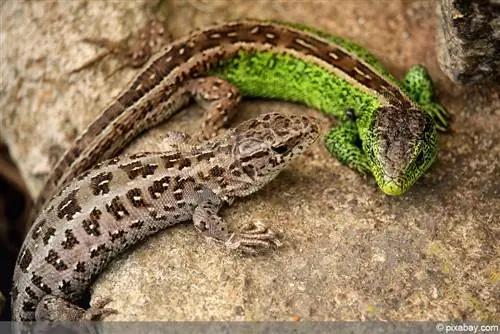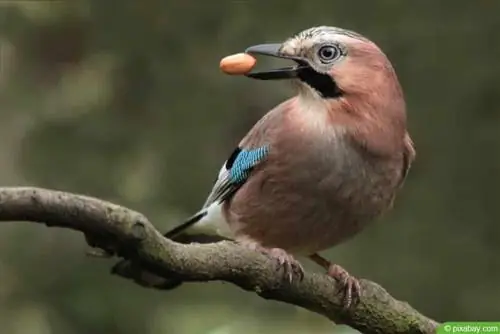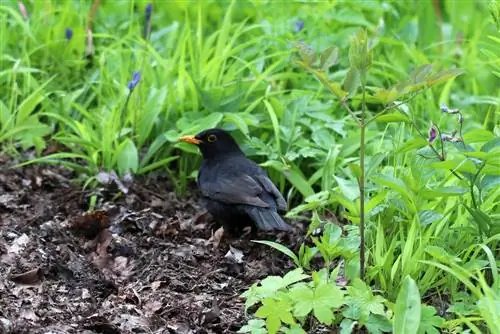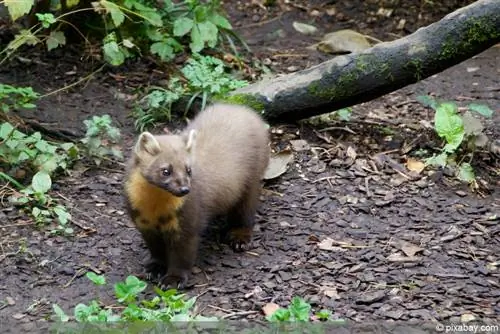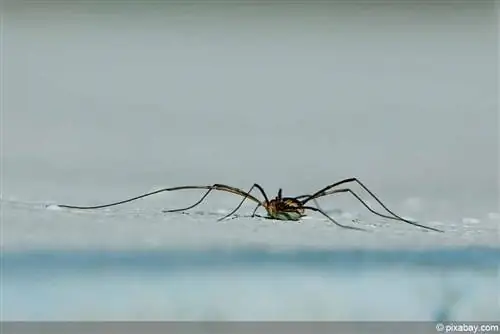- Author admin [email protected].
- Public 2023-12-17 03:39.
- Last modified 2025-01-24 12:45.
Some people may remember watching a lizard sunbathing on a wall or a stone in the wild. Many children and younger people will hardly have the opportunity anymore, because native lizards are endangered and can only be found rarely. This makes it all the more important to give the beneficial insects a suitable habitat in your own garden.
Native species
Species of lizards native to Germany and Central Europe are:
- Wall Lizard
- Sand Lizard
- Eastern and Western Emerald Lizard
- Forest Lizard
- Croatian mountain lizard
Their distribution areas vary greatly, but they all have one common use in the garden. Since insects are on their menu, they can prevent pests from spreading excessively and thus help protect plants. If you want to specifically promote them in your own garden and thus use them as natural pest controllers, you have to offer them an appropriate habitat. Of course, you first have to know what type of lizard it is.
Wall Lizard
Size: 22 to 25 cm
Physique: very slim with a relatively long tail
Color: brown to gray, male with black dots or net pattern on the back
Distribution: southern and western Germany, wine regions around the Moselle, Neckar and Rhine
Habitat: Dry stone walls, rocks, rocky areas
Mating season: March to June
Food: Insects, spiders
Wall lizards are strictly protected and are already on the warning list of the so-called red list due to their dwindling numbers. The red list contains endangered animal species that require special protection.
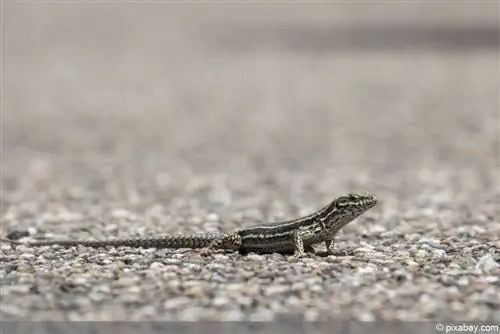
If you want to welcome the wall lizard into your own garden, you should create a dry stone wall, pile of stones or a rock garden that is particularly sunny and warm. Cracks in walls, crevices and small caves are very popular with lizards and serve as life-saving hiding places - both for themselves and for their clutches. There are up to three of these between March and June. Hatching occurs two to three months after egg laying. In order not to disturb or even damage the eggs in the wall lizards' clutches, no changes should be made to the stone landscape during this time.
Sand Lizard
Size: up to 24 cm, usually smaller
Physical structure: strong body, clearly defined head, short legs and relatively short tail
Color: green, gray and brown possible, mostly patterned
Distribution: all over Germany but rare
Habitat: Walls, densely vegetated areas, wild gardens, quarries, forest edges and heaths
Mating season: March to July
Food: Worms, insects, spiders
Sand lizards were once widespread because they are not restricted to one habitat. They prefer areas with dense plant growth and open spaces. As a result, they often occur in border areas, such as a dry edge of the forest.
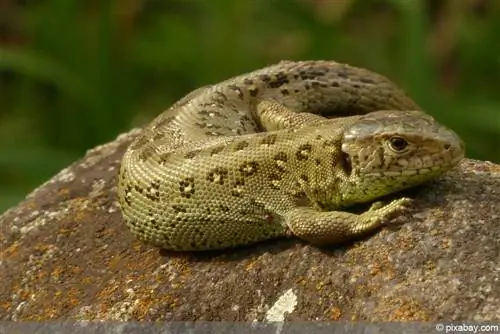
In the home garden, this species of lizard can be offered a suitable habitat if a section of the garden is allowed to grow wild or is otherwise very densely overgrown - and no maintenance measures are required. Stones and warm, dry walls are also welcome. Again, it should be noted that from March until around September or October there is no intervention in the area reserved for sand lizards. Both the animals and their clutches could be damaged and frightened.
Eastern and Western Emerald Lizard
Size: up to 35 cm
Physique: slim, pointed head
Color: initially brownish, later green on the body, some with blue markings on the head
Distribution: Eastern green lizard in eastern Germany and along the eastern Danube, western green lizard in Hesse and the Rhine Valley
Habitat: Overgrown slopes with moist soils
Mating season: March to around June
Food: Snails, larger insects, spiders, small vertebrates (such as young mice)
The green lizards are very impressive animals due to their coloring and size, but unfortunately they are extremely rare. Due to a very small gene pool in the eastern and western populations, there is an increasing number of infertile offspring despite relatively large clutches of up to 15 eggs. The number of lizards is therefore increasingly shrinking.
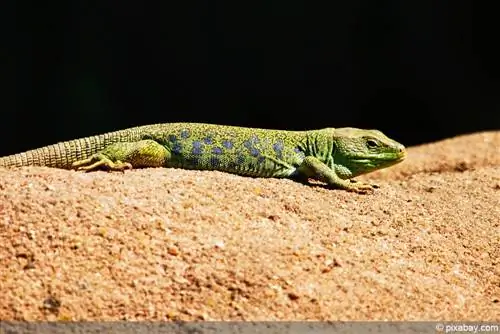
Their preferred living area consists of slopes, which, however, must not be too dry. Due to increasing changes in agriculture, these areas are becoming more and more degraded. A habitat in the garden can actually only be offered to them by providing a wild, moist slope. This is only possible in very few cases.
Forest Lizard
Size: about up to 18 cm
Body type: Slim, very long tail of up to two thirds of the total body length
Color: brownish, partly with stripes on the back
Distribution: throughout Europe
Habitat: Heaths, moors, quarries, mountain landscapes, lowlands, forest edges, grasslands
Mating season: April to May
Food: small insects and spiders
The forest lizard is widespread, but like other lizards, it is now only rare. In the garden at home it is important to offer it enough hiding places and undisturbed areas. Again, stones and dry, warm walls, overgrown sections and as few interventions as possible are optimal.
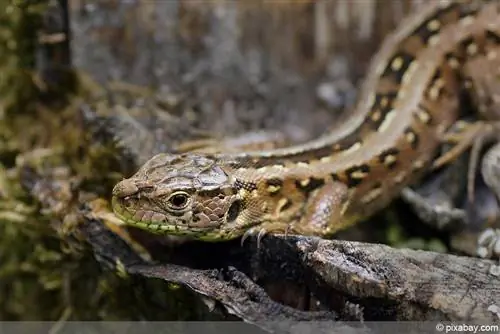
Due to their small size, the forest lizards' menu only includes small insects, such as caterpillars, flies and small beetles.
Croatian mountain lizard
Size: 16 to 18 cm
Body type: slim and petite, tail significantly longer than body
Color: beige to brownish with darker stripes on the back but also light gray or green
Distribution: Croatia, Slovenia, Austria, Northern Italy and German Alps
Habitat: stony, bushy areas, in rather humid and cool areas
Mating season: Spring to summer, little is known about reproduction
Food: Snails, insects and spiders
The Croatian mountain lizard can occasionally be observed in groups, but is very quick and agile and also very well adapted to its preferred substrate. A suitable habitat can be created in your own garden with dry rockeries and dense planting.
Food
So that the native lizards have enough and suitable food in the garden, no pesticides may be used. This not only reduces the insects, but also turns them into potential poison bait for the lizards.
If you don't want to drive the reptiles out of the garden, but rather offer them appropriate habitats and food sources, pay attention to the following factors:
- Setting up an insect hotel
- Only use natural-based pesticides when necessary, such as plant manure
- Let a corner of the garden go wild
- Planting insect-attracting plants
- Cracked walls or piles of stones where insects can settle
- Leave rotten wood lying around
- Introduce wild perennials
- Leave the garden as close to nature as possible
Wintering
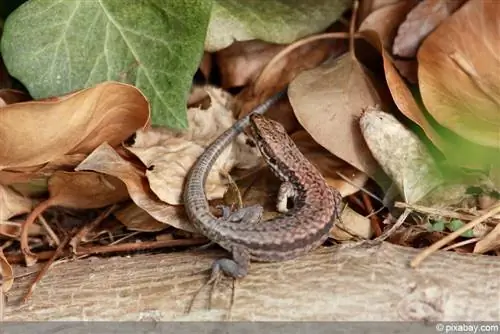
Lizards are cold-blooded animals that become rigid when temperatures drop. In order to survive the winter well in this way, they need sufficient reserves on the one hand and a hiding place that is as frost-free as possible on the other. They can create reserves if there are enough insects in their environment. They prefer the abandoned underground burrows of other animals, such as mice, moles and rabbits, as hiding places. Humans initially have no direct influence on this, but should refrain from closing existing corridors or blocking entrances. Heaps of leaves or stones protected with brushwood and leaves also offer the lizards places to hide during the winter.
If a lizard is found outside of a hiding place, it can be housed in a cool but frost-free room. A terrarium that is lightly filled with leaves is suitable to provide the lizard with protection and security. With this form of hibernation, it is also important to check the lizard frequently but carefully. It should not be disturbed every day, but it must be known whether it is really in hibernation or is already active again due to high temperatures. If it is active because temperatures rise above 10°C, it also needs to be fed.
As a rule, it is better - if it is still above zero - to bring the lizard close to a protected area during the day and let it search for a suitable hiding place on its own. Again, piles of leaves or piles of stones are well suited as a place to settle.
Garden care
With the exception of the wood lizard, all native lizards lay their eggs. The forest lizard, on the other hand, carries it in a sack on its body until it hatches and thus brings its offspring into the world alive. Special consideration should be given to these clutches and the growing offspring from spring to autumn. Again, a few points can be taken into account to give the reptiles the highest possible chance of survival in your own garden. These include:
- Create hiding places, such as walls and piles of stones with cavities and dense vegetation
- Allowing a garden area to become wild
- No digging or mowing the lawn in overgrown garden areas
- During the respective mating season, avoid carrying out any very loud or large-scale grooming measures
- Adapt the “wild” area to the characteristics of the respective lizard species
Tip:
Even with the measures mentioned, there is unfortunately no guarantee that native lizards will settle permanently. A “wild” garden corner, offered hiding places and gentle care of your own greenery gives numerous animal species the opportunity to inhabit the garden.

